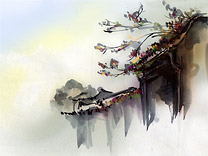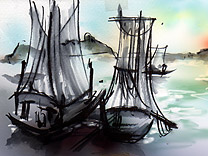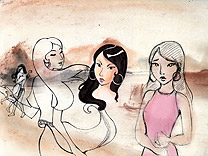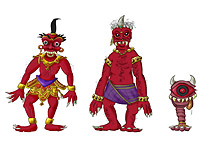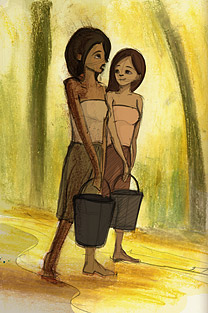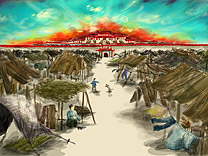An introduction by Hannes Rall
Why Tradigital Mythmaking?
When I first arrived in Singapore from Germany, I was overwhelmed and fascinated by the multifaceted cultural traditions from all parts of Asia, which are present in this vibrant cosmopolitan city.
I also came with a personal background as an independent animation film director, who had succeeded in transforming classic literature, specifically in the form of poems and ballads into animated short films. This defined and informed my research interest to a large degree.
For a long time German animation had been dominated by the attempt to copy primarily American animation styles, as represented through the “Disney”-style.
(Which, ironically, itself took a lot of its own inspiration from 19th century European children’s book illustrations).
Beginning in the late 1980s a movement of the creation of independent animation began to evolve in Germanys leading art schools:
No longer were cute animals and sweet princesses the norm, but bold attempts were made to design images, which reflected more modern art styles and adult storytelling.
In my own films, “The Raven” and “The Erl-King”, I tried to combine the influences of the famous German animation pioneer Lotte Reiniger, the German expressionist movement and contemporary comic styles to create something new and, yes, genuinely German.
If success at festivals is any proof, that approach was met with some success:
The films were shown in over 100 film-festivals.
“The Raven” also became the leitmotif of the traveling exhibition and film-show “Animated Film from Germany”, organized by the German Institute for Foreign Relations (IFA) and the Goethe Institutes worldwide. This exhibition was shown in over 20 countries in prominent venues, such as eg the Teheran Museum of Contemporary Art, Singapore’s National Museum, the International Bangkok Film Festival and the Osaka European Film Festival.
The exhibition traveled most of the major Southeast Asian countries, such as Singapore, Thailand, Malaysia, Vietnam, Indonesia and the Philippines.
A deepened relation with several of these countries and their animation traditions evolved from my involvement with the exhibition:
As a follow up to the exhibition, I was happy to conduct several workshops in these countries, always meeting a very attentive and enthusiastic audience of young and aspiring animation filmmakers.
This always left me highly impressed with their undeniable talent and the rich cultural heritage, they would be able to draw from to create their very own brand of animation.
At the same time, the analysis of the trends in primarily commercial Asian animation, as created in Southeast Asia drew a different picture:
Again, there was a prevalent tendency to copy western styles and formats, or in almost the same manner to deliver content in the Japanese manga or anime styles.
Being fully aware of the artistically exceptions from this rule (such as the wonderful films of Studio Shanghai (“The Boy with the Bamboo Flute”), I was asking myself a question:
-What if I tried to help young animation artists in Singapore to discover their own cultural heritage?
-Why not encourage young animators and designers to improvise and develop from the amazing richness and beauty of Asia´s diverse art styles?
-Wouldn’t there be an immense potential to create new and exciting styles, which truly reflect the idea of Singapore as a multicultural city?
-Is there an opportunity to create local stories with global appeal, derived from Asian mythology and folk tales?
As I found the answer to these questions to be yes, even more fascinating insights struck me: Inevitably, the question of the Singaporean identity expressed through the means of art was raised: An identity, which possibly could be defined through a cultural diversity, which truly reflected the peaceful and crosspollinating existence of cultures in Singapore.
Also, as the Western influence is also a true part of the upbringing and cultural awareness of the young generation in Singapore, shouldn’t that also be a relevant factor in creating a new and exciting visual style?
With all of these questions in mind, I started the research with a large group of students at the School of Art, Design and Media at Singapore’s Nanyang Technological University.
It was fascinating to see them discover their own cultural heritage through research in Asian mythologies and art history. Wherever possible I tried to have students from the respective countries to cover the research on their own nation’s cultural history. Field trips were conducted to find inspiration and visual reference locally. This material provided an important stepping-stone for the visual development of the different stories for animated content.
As expected, there was a whole treasure trove of beautiful storytelling to be unearthed in the realm of Asian mythologies. From these discoveries, six stories were selected to be transformed into scripts, storyboards and pre-production art for animated films of different formats.
Over the course of two years this process created an abundance of beautifully drawn art paired with concepts, what we believe would be exciting films for a global audience.
Looking at the results, I am especially pleased with the stylistic variety of the material represented through the works of these young Asian artists.
Equally fascinating is the process of visual development, as documented here:
It shows, that content creation and design is largely an evolutionary process, based on constant refinement and a solid basis in artistic research and visual reference.
As the supervisor of this research project, I had decided early on, to let the students find their own artistic language, only subtly enhancing and sensitively guiding their artistic journey. Hopefully, the attempt to create visual concepts, which mirror the cultural diversity and richness of Singapore and Asia, has been successful-but I will leave that for others to judge.
The concepts shown in this book are the first step to the creation and defining of a new approach to digital animated content in Asia.
A first step which ultimately shall lead of course to the production of these films and their successful journey through the festivals of this world.
My further goal is also cooperate with experts in state of the art technology to make the beauty of the artistic vision come alive in the most compelling and fascinating way thinkable. As the worlds of art and technology move closer and increasingly influence each other, a quite fascinating prospect for the future.
In the 1920s German animation pioneer Lotte Reiniger had been strongly influenced in her work by oriental art. With my artistic research, I am happy to be able to work with young local artists and be able to influence and assist the creation of new Asian styles in animation.
Finally I want to welcome everybody to the exciting journey of discovery this book provides-enjoy!
Singapore, November 2008
Hannes Rall



